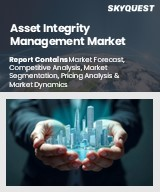
세계의 자산 완전성 관리 시장 규모는 2023년에 232억 9,000만 달러에 달하며, 예측 기간(2025-2032년)의 CAGR은 5.7%로, 2024년 252억 6,000만 달러에서 2032년에는 393억 6,000만 달러로 성장할 전망입니다.
세계 자산 무결성 관리(AIM) 시장은 노후화된 인프라에 대한 적극적인 유지보수 필요성, 규제 및 안전 요건 강화, IoT 및 디지털 트윈과 같은 기술 발전 등 몇 가지 강력한 요인에 의해 주도되고 있습니다. 석유 및 가스, 전력, 제조업 등의 산업에서는 환경적 지속가능성을 중시하는 동시에 운영 비용과 다운타임을 최소화하는 것을 우선시하는 경향이 강해지고 있습니다. 첨단 기술 도입으로 실시간 모니터링과 예지보전이 용이해져 노후화된 자산의 수명을 연장할 필요성이 높아지고 있습니다. 그러나 시장은 고가의 초기 투자, 레거시 시스템과의 복잡한 통합, 숙련된 전문가 부족, 일관성 없는 규제 환경, 증가하는 사이버 보안 위협 등의 문제에 직면해 있습니다. 전반적으로 IoT의 통합은 유지보수 비용을 절감하고, 자산의 신뢰성을 높이고, 컴플라이언스를 보장하면서 AIM에 혁명을 일으키고 있습니다.
Global Asset Integrity Management Market size was valued at USD 23.29 Billion in 2023 and is poised to grow from USD 25.26 Billion in 2024 to USD 39.36 Billion by 2032, growing at a CAGR of 5.7% during the forecast period (2025-2032).
The global Asset Integrity Management (AIM) market is driven by several compelling factors, including the need for proactive maintenance of aging infrastructure, heightened regulatory and safety requirements, and technological advancements such as IoT and digital twins. Industries like oil, gas, power, and manufacturing increasingly prioritize minimizing operational expenditure and downtime while emphasizing environmental sustainability. Implementing advanced technologies facilitates real-time monitoring and predictive maintenance, addressing the growing urgency to prolong the lifespan of aging assets. However, the market faces challenges including high initial capital investments, integration complexities with legacy systems, a shortage of skilled professionals, inconsistent regulatory environments, and rising cybersecurity threats. Overall, the integration of IoT is revolutionizing AIM by enhancing asset reliability and ensuring compliance while reducing maintenance costs.
Top-down and bottom-up approaches were used to estimate and validate the size of the Global Asset Integrity Management market and to estimate the size of various other dependent submarkets. The research methodology used to estimate the market size includes the following details: The key players in the market were identified through secondary research, and their market shares in the respective regions were determined through primary and secondary research. This entire procedure includes the study of the annual and financial reports of the top market players and extensive interviews for key insights from industry leaders such as CEOs, VPs, directors, and marketing executives. All percentage shares split, and breakdowns were determined using secondary sources and verified through Primary sources. All possible parameters that affect the markets covered in this research study have been accounted for, viewed in extensive detail, verified through primary research, and analyzed to get the final quantitative and qualitative data.
Global Asset Integrity Management Market Segments Analysis
The global asset integrity management market is segmented by service type, end use, and region. Based on service type, the market is segmented into non-destructive testing (NDT), risk-based inspection (RBI), corrosion management, pipeline integrity management, hazard identification (HAZID) study, and structural integrity management. Based on end use, the market is segmented into oil and gas, power, mining, and aerospace. Based on region, the market is segmented into North America, Europe, Asia Pacific, Latin America, and the Middle East and Africa.
Driver of the Global Asset Integrity Management Market
One of the key market drivers for the Global Asset Integrity Management Market is the increasing focus on operational efficiency and regulatory compliance across various industries. As organizations strive to maximize asset lifespan and reduce operational risks, the demand for effective asset integrity management solutions has surged. The growing emphasis on safety, environmental stewardship, and adherence to industry regulations compels businesses to implement robust integrity management practices. Additionally, the rising costs associated with asset failures and maintenance downtime further motivate companies to invest in advanced technologies and services that ensure optimal performance, reliability, and safety of their assets throughout their operational lifecycle.
Restraints in the Global Asset Integrity Management Market
One of the key market restraints for the Global Asset Integrity Management Market is the high implementation and maintenance costs associated with advanced asset integrity technologies and solutions. Organizations often face budget constraints, which can limit their ability to invest in comprehensive integrity management systems. Additionally, the complexity of integrating these systems with existing infrastructure and processes can deter companies from adopting asset integrity management solutions. Furthermore, a lack of skilled personnel to effectively manage and operate advanced technologies leads to operational inefficiencies, thereby hindering market growth and adoption across various sectors, including oil and gas, manufacturing, and utilities.
Market Trends of the Global Asset Integrity Management Market
The Global Asset Integrity Management market is witnessing a notable trend towards the adoption of predictive maintenance strategies powered by digital twin technology. This innovation enables organizations to perform real-time monitoring and simulate asset behavior, thereby anticipating potential failures before they occur. As businesses increasingly embrace these advanced methodologies, they are able to optimize maintenance schedules, significantly reduce downtime, and extend the lifespan of their assets. This transition reflects a broader industry shift toward proactive management, improving operational efficiency while concurrently minimizing risks and operational costs. The growing emphasis on these technologies indicates a promising future for asset integrity management solutions across various sectors.